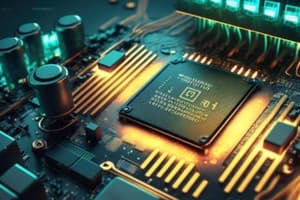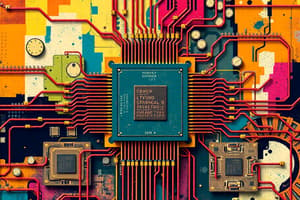Podcast
Questions and Answers
What is the primary function of a down counter?
What is the primary function of a down counter?
- To increase the value of a count by 1 in each clock cycle
- To store binary values for calculation purposes
- To decrease the value of a count by 1 in each clock cycle (correct)
- To perform specialized logic functions
Which of the following is NOT an example of a microoperation?
Which of the following is NOT an example of a microoperation?
- Clearing the contents of a register
- Shifting a value in a register
- Programming a PLA device (correct)
- Counting in a counter
What is the main purpose of Register Transfer Notation (RTN)?
What is the main purpose of Register Transfer Notation (RTN)?
- To describe the sequence of microoperations in a digital synchronous circuit (correct)
- To provide a visual representation of a counter circuit
- To store binary values for mathematical calculations
- To represent the logical functioning of a PLA device
What is the role of the Control Unit (CU) in relation to registers?
What is the role of the Control Unit (CU) in relation to registers?
Which of the following statements accurately describes a Programmable Logic Array (PLA)?
Which of the following statements accurately describes a Programmable Logic Array (PLA)?
What is the primary role of the Control Unit in the Von Neumann Architecture?
What is the primary role of the Control Unit in the Von Neumann Architecture?
What enables a single processor to manage diverse external devices, regardless of their speed differences?
What enables a single processor to manage diverse external devices, regardless of their speed differences?
Which part of the processor holds the instruction being actively executed?
Which part of the processor holds the instruction being actively executed?
Why is data access in general-purpose registers significantly faster compared to memory locations?
Why is data access in general-purpose registers significantly faster compared to memory locations?
In the context of the Von Neumann architecture, what is the primary purpose of the Memory Unit?
In the context of the Von Neumann architecture, what is the primary purpose of the Memory Unit?
What does the Program Counter (PC) contain during the execution of an instruction?
What does the Program Counter (PC) contain during the execution of an instruction?
Which register is used to store the address of the memory location where data is being transferred?
Which register is used to store the address of the memory location where data is being transferred?
What is the primary difference between primary memory and secondary storage in the Von Neumann architecture?
What is the primary difference between primary memory and secondary storage in the Von Neumann architecture?
What is the term used to describe the number of bits that can be stored in a single memory location in the Von Neumann architecture?
What is the term used to describe the number of bits that can be stored in a single memory location in the Von Neumann architecture?
What is the role of the Memory Data Register (MDR) in data transfer operations?
What is the role of the Memory Data Register (MDR) in data transfer operations?
What is the purpose of a counter in a computer system?
What is the purpose of a counter in a computer system?
Which of the following is NOT a characteristic of primary memory in the Von Neumann architecture?
Which of the following is NOT a characteristic of primary memory in the Von Neumann architecture?
What is the primary function of the Arithmetic and Logic Unit (ALU) in the Von Neumann architecture?
What is the primary function of the Arithmetic and Logic Unit (ALU) in the Von Neumann architecture?
What is the primary function of the CPU in the von Neumann architecture?
What is the primary function of the CPU in the von Neumann architecture?
Why are registers used in the processor of a Von Neumann architecture system?
Why are registers used in the processor of a Von Neumann architecture system?
What is the role of the control unit (CU) within the CPU?
What is the role of the control unit (CU) within the CPU?
Which unit in the Von Neumann architecture coordinates the operations of all other units and acts as the nerve center?
Which unit in the Von Neumann architecture coordinates the operations of all other units and acts as the nerve center?
Which of the following is NOT a characteristic of the von Neumann architecture?
Which of the following is NOT a characteristic of the von Neumann architecture?
What is the primary reason for using secondary storage in the Von Neumann architecture?
What is the primary reason for using secondary storage in the Von Neumann architecture?
What is the purpose of registers within the CPU?
What is the purpose of registers within the CPU?
What type of devices are typically used as input units for a von Neumann architecture?
What type of devices are typically used as input units for a von Neumann architecture?
How does the von Neumann architecture achieve its general-purpose nature?
How does the von Neumann architecture achieve its general-purpose nature?
Which of the following best describes the relationship between the CPU and the main memory in the von Neumann architecture?
Which of the following best describes the relationship between the CPU and the main memory in the von Neumann architecture?
Why is the ability of the von Neumann architecture to address memory by location important?
Why is the ability of the von Neumann architecture to address memory by location important?
Flashcards
Memory Unit
Memory Unit
Stores programs and data in a computer system.
Primary Memory
Primary Memory
Main memory containing bits stored in semiconductor cells, organized in words.
Von Neumann Architecture
Von Neumann Architecture
A computer architecture where data and instructions are stored in the main memory.
Central Processing Unit (CPU)
Central Processing Unit (CPU)
Signup and view all the flashcards
Word Length
Word Length
Signup and view all the flashcards
Memory Access Time
Memory Access Time
Signup and view all the flashcards
Control Unit (CU)
Control Unit (CU)
Signup and view all the flashcards
Arithmetic/Logic Unit (ALU)
Arithmetic/Logic Unit (ALU)
Signup and view all the flashcards
Secondary Storage
Secondary Storage
Signup and view all the flashcards
Arithmetic and Logic Unit (ALU)
Arithmetic and Logic Unit (ALU)
Signup and view all the flashcards
Registers
Registers
Signup and view all the flashcards
Input Unit
Input Unit
Signup and view all the flashcards
Registers
Registers
Signup and view all the flashcards
Control Unit
Control Unit
Signup and view all the flashcards
Instruction Execution
Instruction Execution
Signup and view all the flashcards
General-purpose computer
General-purpose computer
Signup and view all the flashcards
Up Counter
Up Counter
Signup and view all the flashcards
Down Counter
Down Counter
Signup and view all the flashcards
Programmable Logic Array (PLA)
Programmable Logic Array (PLA)
Signup and view all the flashcards
Register Transfer Notation (RTN)
Register Transfer Notation (RTN)
Signup and view all the flashcards
Synchronization Signals
Synchronization Signals
Signup and view all the flashcards
Instruction Register (IR)
Instruction Register (IR)
Signup and view all the flashcards
Program Counter (PC)
Program Counter (PC)
Signup and view all the flashcards
General Purpose Registers
General Purpose Registers
Signup and view all the flashcards
Memory Address Register (MAR)
Memory Address Register (MAR)
Signup and view all the flashcards
Memory Data Register (MDR)
Memory Data Register (MDR)
Signup and view all the flashcards
Counter
Counter
Signup and view all the flashcards
Study Notes
Von Neumann Architecture
- Data and instructions are stored in the main memory.
- Memory content is addressable by location.
- Instructions are executed sequentially, unless explicitly modified.
- The central processing unit (CPU) coordinates instruction execution.
- The CPU includes a control unit (CU) and an arithmetic logic unit (ALU).
- The ALU performs arithmetic and logical operations.
- Von Neumann computers are general-purpose machines.
- They can solve diverse problems.
Basic Organization of Von Neumann Machine
- The computer consists of interconnected units.
- These units include the computer, CPU, main memory, input unit, and output unit.
The Von Neumann Architecture: Input Unit
- Accepts coded information from human operators through electromechanical devices like keyboards.
- The information received is either stored in memory or immediately used by the ALU for operations.
- The result is sent back to the outside world through the output unit.
- Keyboards translate key presses into their corresponding letter/digit codes and send them to the memory or processor.
- Input devices include joysticks, trackballs, mice, and scanners.
Von Neumann Architecture: Memory Unit
- Stores programs and data (primary memory or main memory)—holds data during execution.
- Consists of semiconductor cells for storing bits.
- Cells are grouped into words, each containing a fixed number of bits.
- Each word has a unique address for data retrieval.
- Accessing one word takes a constant time called memory access time (varies from 10ns to 100ns).
- Memory is fast but expensive.
- Secondary storage is also used when large amounts of data need to be stored.
- Examples include hard disks, compact disks, floppy disks, and magnetic tapes.
Von Neumann Architecture: Processor Unit
- The heart of the computer system houses the processor, consisting of the ALU and registers.
- The ALU executes most computer operations (arithmetic and logical).
- Operands from memory are brought to the ALU for operations, like addition.
- The ALU then stores the result in memory or keeps it in the processor for use.
- The processor contains registers to store frequently used data (operands) as they access these faster than memory.
- Registers store one word of data. Register access is much faster than accessing main memory.
Von Neumann Architecture: Control Unit
- The control unit coordinates actions of all units by sending control signals to them.
- It acts as the nerve center.
- The control unit produces timing signals needed in input/output operations.
- The control unit selects, interprets, and executes program instructions.
- In order, to perform its functions efficiently, registers like Instruction register (IR) and Program Counter (PC) are required
Processor Internal Organization
- Registers are used for temporary storage of data and other information within the processor.
- The Instruction Register holds the currently executing instruction.
- The Program Counter points to the next instruction to be executed.
- General-Purpose Registers are used for data communication and are faster compared to main memory access.
Fundamental Building Blocks
- Counter: Device for storing/displaying the number of times an event/process has occurred. Up & Down counters.
- Counters count in natural binary
- Registers: Temporary storage locations within the CPU specifically designed for a purpose. Data stored for manipulation, calculations.
- PLAs (Programmable Logic Arrays): General-purpose logic devices that can perform various logic functions. Contains AND-OR-NOT gates
Register Transfer Notation
- Micro-operations are operations conducted on data in registers. Examples include
shift,count,clear,load. - RTN (Register Transfer Notation): Symbolic notation for specifying the sequence of micro-operations.
- RTN is useful to specify the behavior of a digital synchronous circuit. An example would be copying data from Instruction Register (IR) to Memory Address Register (MAR).
Studying That Suits You
Use AI to generate personalized quizzes and flashcards to suit your learning preferences.





